Jutland
Peninsula
Danish
History

The North Sea meeting the Baltic Sea at Grenen, Denmark, northern
most tip of Jutland
photo Cheryl Christenson 2016
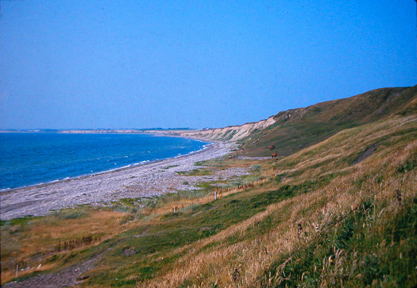
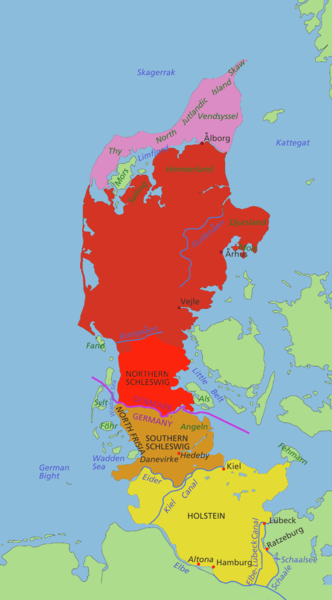
View of Nissum Bredning, a bay off the North
Sea
Map
of Jutland
from
Askov Christoffersen's farm in
Thy.
courtesy
of Wikimedia Common
photo
Elroy Christenson 1985 the pink area is Thy,
Bredning Bay is the s. most
end.
The Danes that occupied this western most peninsula of Denmark
are constantly being harassed by the relentless weather of the
North Sea. It may have helped to produce a people of extreme
hardiness and independence. This is one of the toughest
regions of all Denmark. A few miles from Vestervig begins
Thy National Park, Denmark's first national park, on the west
coast. It's relentless winds, blowing sands and eroding
tides have forced the abandonment of Bronze Age settlements and
villages along with more contemporary farms within the park
boundaries. The remains of Bronze Age burial mounds are only
a few miles from where my various known grand parents lived.

The dolmen remains at Lindeskov of Langdysse #6, island of Fyn,
Denmark, about 3500 - 3100 BC
photo Elroy Christenson 2016
There are numerous mounds around present day Denmark testify to
the age of the habitation patterns. My own DNA tests
seem to indicate that my families lived in this and areas of
southern Norway for hundreds of years perhaps back as far as
10,000 bce. These northern peoples were very migratory using the
open seas and frozen waters to inhabit the vast spaces either for
temporary foraging or more permanent settlements. The mounds of Ydby
Heath go back to 1100 bce to 1600 bce. Other burials
have gone back further but intense cultivations has eliminated
some signs. Over the centuries some of the mounds and stones
have been removed and the land plowed over.
Viking culture may have been created here although
trade had taken place throughout the region much earlier. The
Viking village of Lindholm, just north of Aalborg was abandoned
due to encroaching sand dunes.
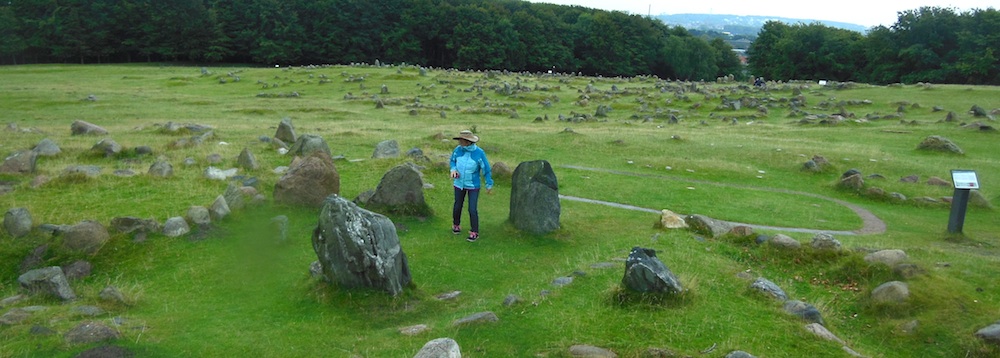
Lindholm Høje (hill), cemetery,
Aalborg, Denmark c1000-1100 AD
photo Elroy Christenson 2016
The remains recovered from the burials have provided clues to the
richness of the culture while some of the marking stones may have
been crushed to build roads in the 1800's. The more
protected areas of Aalborg were used to stage invasions of Europe.
Viking settlements at Ribe in Denmark and Hedeby, one of the
largest trade towns in northern Europe in 1100 AD, is about a 4
hours drive south to what is just over the border into what is now
northern Germany known as Haithabu-Dannewerk, Germany.
Although this area of Scandinavia may have been foraged from the
end of the Ice Age in 10,000 bce, the environment was not an easy
place to remain. Short growing seasons, cold and blowing winds,
and long dark winters required creativity and stubbornness.
With the development of agriculture it was also necessary to be
particularly frugal and protective of their families and their
animals. The environment may have aided in creating warriors
of a people that would not give up to the Teutons, Romans or
Charlemagne. According the story of Beowulf, The Skjoldungs (the Men of the Shield)
were the legendary kings of Denmark and descended from Skjold, the
son of Odinn, who according to Ynglinga
Saga was the grandson son of Dan. [Jones 45] Odin is, of
course, one of the great gods of Scandinavia. Little
accuracy can be authenticated from these legends. Rather
they show that the tribes existing in the north were constantly
battling with one another.
Various tribes may have lived on Jelling(Jutland) including the
Eurli, the Angles, the Dani, the Saxons, the Jutes and the Cimbri.
The Cimbri tribe were the known residents on Jutland. Climate
change may have pushed them out to initially migrate south. They
were not alone since the Longobards, Burgundians, Visigoths,
Ostrogoths, Alamanus, and Franks were also on the move pillaging
as they went. The Cimbri first raided into Bulgi and then Roman
controlled Gaul(France) on their own about 113 A.D. On later
forays the Cimbri combined forces with the Teuton tribes to
eventually invade the territories that had been controlled by the
Romans all the way to the Mediterranean. Their ferocity in battles
marked them as dangerous to Roman stability. The Jutland
became known as Cimbria while the war with the Romans became known
as the Cimbria War (113-101bce). The Roman defeat at Orange
(now France) was described by Orosius about c105 in his History of the World:
"The enemy (the Cimbri) captured
both camps and acquired an enormous quantity of booty. In
accordance with a strange and unusual vow, they set
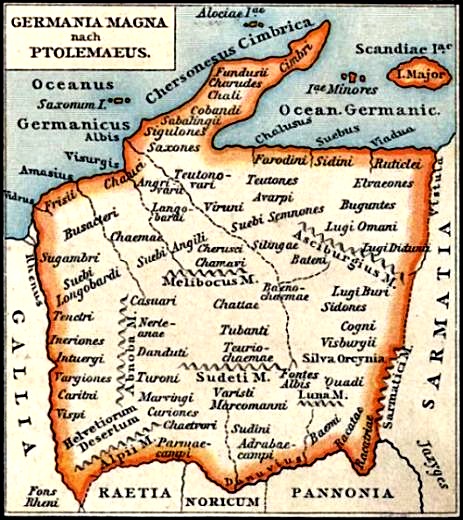
about destroying everything
which they had taken. Clothing was cut to pieces and cast away,
gold and silver was thrown into the river, the breastplates of the
men were hacked to pieces, the trappinges of the horses were
broken up, the horses themselves downed in whirlpools, and men
with nooses round their neck were hanged from trees. Thus there
was no booty for the victors and no mercy for the vanquished.
[Jones 21]
Strabo, another Roman, wrote about some the ceremonies he
witnessed in the 1c a.d. related to the Cimbri priestesses.
He stated that they were dressed in white robes. They decked
out their captives with garlands before leading them to a huge
bronze cauldron. The captives were hoisted by the feet over
the cauldron where the priestess would climb a ladder to slit
their throats. The blood would then flow into the cauldron from
the human sacrifice. On these forays across the Roman empire the
Cimbri made contacts and connections with the Baltic region for
plunder and trade. The combined Roman armies defeated them,
however, Roman respect was gained. Forced back to the north the
goods came into Daneland that could be then traded to other
areas. With the collapse of the Roman Empire an opening was
seen for even more profitable trade and raids. [Jones 22]
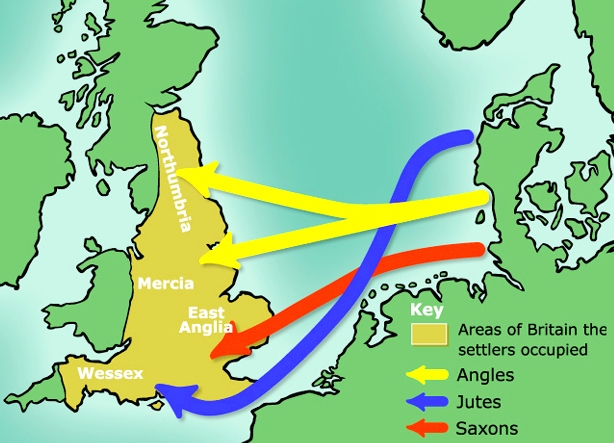 The period between 450 and
1066 was known as the Anglo-Saxon Period. I believe it
should have been more appropriately called "the
Anglo-Saxon-Jutes Period". These tribes have been reported to be
German, however, the tribes were occupying various sections of the
Jelling/Juteland peninsula and should be more appropriately be
referred to as Danish, although that country didn't exist then,
but probably were noted to be of "Magna Germania" based on the
Roman map of Ptolemy. The term of "Dane" doesn't seem to come in
until about 800 with tribes of Dan and Suetidi ("Swedes").
Dane and Danelaw doesn't get recognized until the Viking invasions
in the 800s. Emigration and invasion into the British Isles
stamped them with, at least, a language basis that we refer to as
Anglo-Saxon. The DNA roots indicate this is more
geographically Danish than German. The English term "Germanic" was
used mostly to denote a root from the continent rather than
indigenous to the British Isles. So, with the withdrawal of the
Romans came the disintegration of imperial rule back to only local
rule. The Danish("Germania") tribes found it easy to settle here
and establish a Danish or Scandinavian religion and
government. By the times the Vikings (Norwegians) start
their raids on the British Isles in the 8c the Danes/Jutes had
been well established. It has been argued that Bede, the
"Anglo-Saxon" monk/chronicler, was biased in his interpretation of
Historia ecclesiastica, written in
731. It has been said that there is no evidence of an
Anglo-Saxon-Jute invasion. It was probably more of a long gradual
immigration perhaps even with the Romans. [Bede - wikipedia]
The period between 450 and
1066 was known as the Anglo-Saxon Period. I believe it
should have been more appropriately called "the
Anglo-Saxon-Jutes Period". These tribes have been reported to be
German, however, the tribes were occupying various sections of the
Jelling/Juteland peninsula and should be more appropriately be
referred to as Danish, although that country didn't exist then,
but probably were noted to be of "Magna Germania" based on the
Roman map of Ptolemy. The term of "Dane" doesn't seem to come in
until about 800 with tribes of Dan and Suetidi ("Swedes").
Dane and Danelaw doesn't get recognized until the Viking invasions
in the 800s. Emigration and invasion into the British Isles
stamped them with, at least, a language basis that we refer to as
Anglo-Saxon. The DNA roots indicate this is more
geographically Danish than German. The English term "Germanic" was
used mostly to denote a root from the continent rather than
indigenous to the British Isles. So, with the withdrawal of the
Romans came the disintegration of imperial rule back to only local
rule. The Danish("Germania") tribes found it easy to settle here
and establish a Danish or Scandinavian religion and
government. By the times the Vikings (Norwegians) start
their raids on the British Isles in the 8c the Danes/Jutes had
been well established. It has been argued that Bede, the
"Anglo-Saxon" monk/chronicler, was biased in his interpretation of
Historia ecclesiastica, written in
731. It has been said that there is no evidence of an
Anglo-Saxon-Jute invasion. It was probably more of a long gradual
immigration perhaps even with the Romans. [Bede - wikipedia]
Minimal protection of the local governments made the raids seem a
profitable occupation. It was widely reported throughout the
Catholic world about the slaughter and pillage of the peaceful
group of monks. It was reported in an Anglo-Saxon Chronicle of the
era:
"In the year 787 came three ships to
the West Saxon shores... and they slew folk. These were the
first ships of Danish men that sought land of Engle folk." [Durant
4/483]
One of the most celebrated Danish raids took place on the
monastery on the Island of Lindesfarne off the northeast coast of
Great Britain in 793. This raid became a model for Viking raids
for the next 200 years and created the legend for the violence
that came with them. It made them a feared group throughout
the Medieval world. In 833 a fleet of 350 Viking ship were moored
in the Thames river as they pillage London and Canterbury. In 865
the Danes raided English monasteries and periodic raids continued
until most of northern England was conquered. York and its
cathedral was sack and the village "reduced to destitution and
ignorance" in 867. [Durant 4/483] Although they slaughtered
many original inhabitants, over the next 200 years northern
England was settled by the Danes almost to the city of
London. They establish farms, villages, and trade. They
established a rule of law known as Danelaw based very much on a
jury system above the Thames River. The Danes had many
successive kings that ruled the northern lands of the Isles and
fought against Viking raiders from Norway. Unfortunately, they
also fought against one another too often. The Vikings,
including now Norwegians, invaded England, Ireland and Normandy.
This included several invasions up the Seine River to Paris, one
with two hundred ships. Some of the rulers of northern England
were relatives of Svein
Forkbeard Haraldsson also known as Sweyn of Denmark.
In 1002 Ethelred "the Unready or counseless" conquered several
areas of northern England and ordered the massacre of Danish
settlers including Svein's relatives. Svein became the King of
Denmark in 985 and in 1000 conquered Norway. He demanded and
received payment to keep from invading Ethelred's England.
Ethelred had to establish the first tax in England to pay the
bribe. Finally Svein had just had enough and he drove Ethelred out
to Normandy and Svein now became the King of England as well. The
Saxons fought back and did recapture some land. When Svein dies
Ethelred makes peace with Svein's son, Canute who fled to Denmark
in fear of retribution to become King of Denmark. Ethelred died in
1016 and Canute fights with William Ironside, who lost, and Canute
The Great wins the crown of England. Canute's empire came
apart shortly after his death. England gains independence in
1042 and Norway in 1047. [Durant 4/483-485]
Christianity probably first came into the Jutland with the
captured English monks who had been taken as slaves. It was
a gradual assimilation and conversion. Charlemagne battled Godfred
to the Eider river in Jutland but was not able to conquer them.
His purpose was to convert the heathen north but also to punish
them for their invasions of Franks. The several battles and
the death of Charlemagne in 814 created a stalemate between the
north and the Franks. Christianity made more
conversions by diplomacy and concessions than by battles.[Jones]
Harrald I
"Båltonn /Bluetooth" Gormsson (c910-987) came to power after
his father, "Gorm the old",
had removed the Sweds from the territory. The Catholic
church officially came to the area of in the 10th century. Up to
this point the people here were probably Norse pagans and held
animistic beliefs based on the forces of nature. Harald Bluetooth
came to power and under military and church pressure from Germany
he imposed the church on his Danish realm with some resentment of
his citizens. Two large burial mounds of his parents are nearby
the Jelling Kirke.
"Bluetooth" has come to be known as the writer of the Danish birth
certificate with the inscriptions on the stone at Jelling.
"King Harald bade these memorials
to be made after Gorm, his father, and Thyra, his
mother. The Harald who won the whole of Denmark and
Norway and turned the Danes to Christianity."
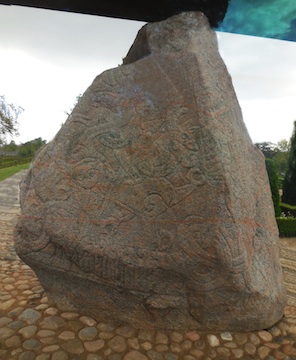
|
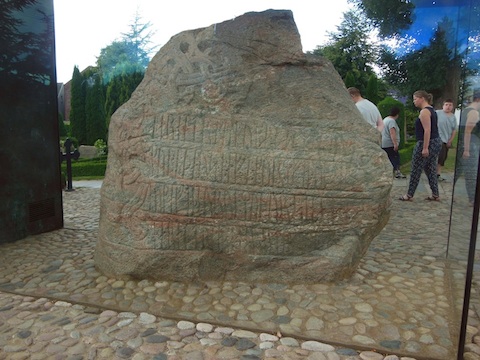
|
Harald I, Bluetooth's stone at
Jelling
photo Elroy Christenson 2016 |
Harald I, Bluetooth's stone at
Jelling, side2
photo Elroy Christenson 2016
|
These stones are difficult to photograph due to the
reflections from the protective glass. While exposed to the
elements they also were subject to vandalism from "taggers" and
have deteriorated in recent history compared with earlier photos.
Inside the Jelling Kirke a
silver line marks the spot where "Old Gorm" is said to
be buried. Gunhild Gormsdatter, Harald I "Bluetooth"s sister
may have had more influence by giving birth to several kings of
Norway. She was known for her beauty, power, scheming and magic.
The introduction of Christianity also brought written
records. Catholic monks recorded births, deaths and
marriages which had previously been very loosely identified and
sometimes recorded from verbal history. These histories,
usually to reinforce a nobleman's claim, could very easily be more
invention than fact. In 1230s, the Southern Jutland became
known as the Duchy of Slesvig. The division began with a feud
among the rulers of Denmark, Canute's great-grandson, Abel
Vlademarsen. Although it remained a Danish fief by
marriage alliances it became closer connected to to the
German Duchy of Holstein. Latin was introduced into the
churches but by the mid to late 1600's the Reformation brought
reform to the church and Danish churches. Northern Jutland
churches started using Danish for services while the Schleswig
churches adopted German. This created a cultural division
between the two areas which remains today.
Vlademar IV Atterdag of Denmark (reign 1340-1375. As the youngest
son of Christopher II, who had bankrupted the country, little hope
was expect of Vlademar. He set about going on a crusade to
Jerusalem without the Pope's permission, made war on Lithuania,
sold the possession of Estonia, declared war on several
German principalities and reunited the country of Denmark.
During his tenure the ghost ship brought the Bubonic plague to
Jutland. quoting Wikipedia article on Vladimar IV here:
In 1349 Bubonic Plague (then
known as the "Black Death") arrived unexpectedly. Tradition has
it that plague came to Denmark on a ghost ship that beached
itself on the coast of northern Jutland. Those who went aboard
found the dead swollen and black faced, but stayed long enough
to take everything of value from it and thereby introduced the
fleas that carried the disease into the population. People began
to die by the thousands. During the next two years plague swept
through Denmark like a forest fire. In Ribe twelve parishes
ceased to exist in a single diocese. A few towns simply died
with no one left alive. The general figures for plague in
1349–50 ranges between 33% and 66% of the people of Denmark.
City dwellers were often harder hit than farm folk leading many
people to abandon towns altogether. Valdemar remained untouched
and took advantage of the deaths of his enemies to add to his
growing lands and properties. He refused to reduce the taxes the
following year though fewer peasants farmed less land. Nobles,
too, felt their incomes shrink and the tax burdens fell heavier
on them as well. Uprisings flared up in the following years.[2]
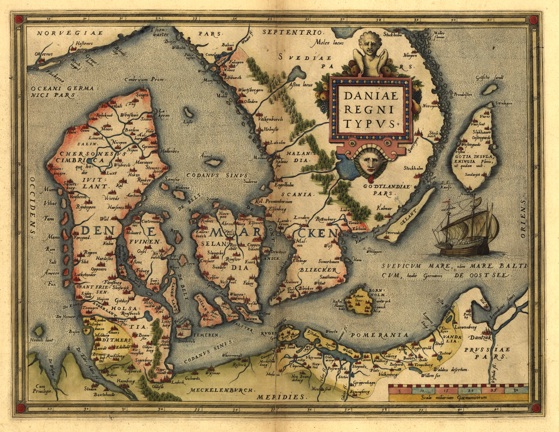
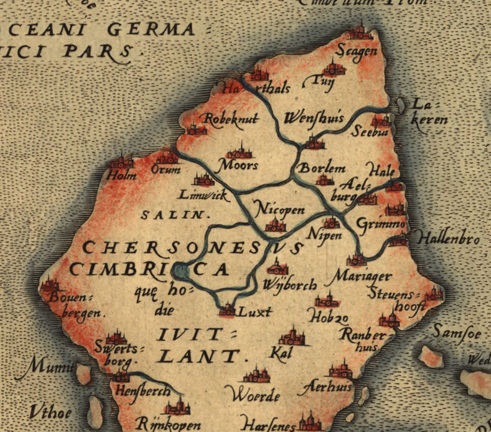
Map of Denmark in 1500's
The names of the towns
have changed a good deal. The towns seem identified to each
have a church. The name of one of the towns in the northern
most province of Thy is listed as Harthals which I believe is
the present town of Hartshal.
Holm is probably
present Hanstholm. These towns that may have been major
trade centers in the 1500's have become less important due to
changes in the geography such as silting of the harbors. Swertsborg is what I
believe is present day Vestervig
in the area known as the Crimea of Cimbria.
Nicopen is the present Nykobing.
The Cimbria were a tribe that fought successfully against the
Romans in the 1c. The lack of accuracy of the map is
typical of the time period. [digital map,
collection of EC]
The ideas of Martin Luther came to the Danish people through
Germany. In 1536 the economic pressures and politics brought
unrest. The peasants were unhappy with the rule of the
Catholic prelates but were also unhappy about having a new king
being imposed from the within. Luther had pointed out the
excesses of the Catholic Pope and economic slavery the church had
created in Germany. The uncle of Christian II had decided to
use this as a reason to change the order and install his son as
King of Denmark. Skipper
Clement, who was a Vice Admiral and pirate for
Christian II, helped to organize a peasant rebellion against the
uncle of Christian II. The failed attempt saw Clement being
executed in Viborg.
During the Reformation of the 1600s the Convent of the Vestervig Kirke was torn
down and the interior was white washed to cover all the images of
saints that had been previously painted on the interior walls.
Even the bricks and timbers from the church were quarried to build
Aalborghus. The simplicity and self-reliant nature of the
protestant faith undoubtedly appealed to these farmers sense of
nature and propriety. [Vestervig
Church]
The 1600's to the 1800's was a reasonably stable time period. The
large manors existed growing crops and dairy products with the
help of the feudal labor. The feudal system wasn't abolished
until the 1800's. One of my grandmothers, Zidsel Sørensdatter, was actually sold
with the mill that her previous husband, Søren Lauritsen, and her
had operated for the lord of the manor. Her second husband
was able to gain legal control of the mill and became a prosperous
land owner by the time he dies in 1788.
Other names in this region that are related is somewhat
confusing because of the naming patterns. For instance Christian's
children would be named Christensen (Christian's son) or
Christensdatter (Christian's daughter). Some of the names are
related to their profession such as a person who owns and operates
a mill would be Møller. It best to follow the family using the
links on Ancestor Chart #1.
See more details on the selected Danish farm and Danish church
connections.
source:
Christenson, Elroy - photos 1985 and 2016
Christoffersen, Kent - interviews and research in Denmark
Hansen, Brent. "Denmark's History - Celtic Iron Age". Dalum
Hjallese Debate Club. Jun 2014
http://www.dandebat.dk/eng-index.htm
Gade, Anders - photo of "Uglev frihedskeampere"
Anders.Gade@psy.ku.dk
"History of Jews in Denmark", www.auschwitz.dk/Denmark.htm
Jones, Gwyn. A History of the
Vikings. revise ed. 1907, Oxford University Press.
London 1984
Map of Demark in the 1500's [digital. collection of Elroy
Christenson]
The United States Holocaust Memorial Museum:
http//:www.ushmm.org/outreach/denchr.htm
"Vestervig Church", Vestervig Church Organ Fund(in English),
Vestervig Kirkes Orgelfond, 7770 Vestervig. Giro 23 77 70, c 1985
Wikimedia Commons, map of Jutland 2008
wikipedia.com - references to Bede and Anglo-Saxon-Jutes
Elroy's Family Index | Ancestor Chart #1 | Surname Index







All information and
photos included within these pages was developed by the
help of hundreds of researchers. The information here is
for the express purpose of personal genealogical
research and is freely offered as long as this site is
listed as a source. It may not be included or used for
any commercial purpose or included in any commercial
site without the express permission of Elroy
Christenson. Copyright Elroy Christenson 1998-2017.




 about destroying everything
which they had taken. Clothing was cut to pieces and cast away,
gold and silver was thrown into the river, the breastplates of the
men were hacked to pieces, the trappinges of the horses were
broken up, the horses themselves downed in whirlpools, and men
with nooses round their neck were hanged from trees. Thus there
was no booty for the victors and no mercy for the vanquished.
[Jones 21]
about destroying everything
which they had taken. Clothing was cut to pieces and cast away,
gold and silver was thrown into the river, the breastplates of the
men were hacked to pieces, the trappinges of the horses were
broken up, the horses themselves downed in whirlpools, and men
with nooses round their neck were hanged from trees. Thus there
was no booty for the victors and no mercy for the vanquished.
[Jones 21] The period between 450 and
1066 was known as the Anglo-Saxon Period. I believe it
should have been more appropriately called "the
Anglo-Saxon-Jutes Period". These tribes have been reported to be
German, however, the tribes were occupying various sections of the
Jelling/Juteland peninsula and should be more appropriately be
referred to as Danish, although that country didn't exist then,
but probably were noted to be of "Magna Germania" based on the
Roman map of Ptolemy. The term of "Dane" doesn't seem to come in
until about 800 with tribes of Dan and Suetidi ("Swedes").
Dane and Danelaw doesn't get recognized until the Viking invasions
in the 800s. Emigration and invasion into the British Isles
stamped them with, at least, a language basis that we refer to as
Anglo-Saxon. The DNA roots indicate this is more
geographically Danish than German. The English term "Germanic" was
used mostly to denote a root from the continent rather than
indigenous to the British Isles. So, with the withdrawal of the
Romans came the disintegration of imperial rule back to only local
rule. The Danish("Germania") tribes found it easy to settle here
and establish a Danish or Scandinavian religion and
government. By the times the Vikings (Norwegians) start
their raids on the British Isles in the 8c the Danes/Jutes had
been well established. It has been argued that Bede, the
"Anglo-Saxon" monk/chronicler, was biased in his interpretation of
The period between 450 and
1066 was known as the Anglo-Saxon Period. I believe it
should have been more appropriately called "the
Anglo-Saxon-Jutes Period". These tribes have been reported to be
German, however, the tribes were occupying various sections of the
Jelling/Juteland peninsula and should be more appropriately be
referred to as Danish, although that country didn't exist then,
but probably were noted to be of "Magna Germania" based on the
Roman map of Ptolemy. The term of "Dane" doesn't seem to come in
until about 800 with tribes of Dan and Suetidi ("Swedes").
Dane and Danelaw doesn't get recognized until the Viking invasions
in the 800s. Emigration and invasion into the British Isles
stamped them with, at least, a language basis that we refer to as
Anglo-Saxon. The DNA roots indicate this is more
geographically Danish than German. The English term "Germanic" was
used mostly to denote a root from the continent rather than
indigenous to the British Isles. So, with the withdrawal of the
Romans came the disintegration of imperial rule back to only local
rule. The Danish("Germania") tribes found it easy to settle here
and establish a Danish or Scandinavian religion and
government. By the times the Vikings (Norwegians) start
their raids on the British Isles in the 8c the Danes/Jutes had
been well established. It has been argued that Bede, the
"Anglo-Saxon" monk/chronicler, was biased in his interpretation of









